#the celt conspiracy
Text
Jewish-Celtic Similarities
So I know I'm late to this, but a while back @nattitavi asked me to please tell more about Jewish-Celtic similarities. This is something that I, too, have some interest in. For context, I'm an American Jew with some Celtic ancestry (my dad's family is """Irish""") and am now living in a Celtic country (not Ireland-don't want to say where exactly I live on the internet). Unfortunately, I don't know of any "scholarly" resources on this topic, but there are some similarities I can think of off the top of my head and have heard brought up in discussions:
Both are communal cultures in which the people help each other out.
Historical dependence on sheep
Indigenous peoples who take responsibility for nature
Long history of persecution and being colonized
Many Celtic rock groups have a lot of Jewish fans and sometimes Celtic rock songs happen to have Jewish themes. For example, to me at least, the song "In a Big Country" by Big Country is clearly about Shoah survivors making new lives for themselves in Israel (but then shouldn't it be called in a small country?), "The Storm", also by Big Country, despite explicitly being about the battle of Culloden just makes me think of 7/10 whenever I listen to it since then, and "Blood" by Dropkick Murphys seems like a good song for Purim (or really any holiday that's "they tried to kill us, we survived").
Using the tree of life as a symbol (although that exists in other cultures, too).
There are some linguistic similarities between Celtic and Semitic languages! I actually do have a source for this: https://www.youtube.com/watch?v=OAAmwtdP1bE
Could the Celts be one or more of the lost tribes? There's some speculation about this that's in the realm of conspiracy theories, but I think it's possible.
177 notes
·
View notes
Text
I've been asked to weigh in.
So.
No, Cleopatra wasn't black. She wasn't even African. Her family was Macedonian Greek, and they were infamously the most incestuous family in Egyptian history. No African DNA got in there. People who saw her while she was alive described her as having, "honey skin." She wasn't Elizabeth Taylor white, but she also wasn't what we'd call black.
That being said, there are PLENTY of Black figures in Egypt. The further back you go in Egyptian history, the less amount of trade routes with other nations, the more African they were. That means that the pyramid builders like Khufu, Khafre, and Menkaure were all likely black. Hatshepsut, the first woman to rule in her own right who established highly successful trade routes with Punt, was likely black. Tutankhamun's grandmother Tiye has always been depicted with dark skin. Queen Ahmose Nefertari was depicted as this:
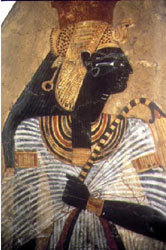
Then there's the entire Kushite Dynasty from Sudan who were black. This was a non-issue for Egypt. The biggest issue was if you worshipped their gods and respected their ways. If you did, then you were in. Alexander the Great was received like a hero because of this while the Persians were hated because of their disrespect for Egyptian culture.
3. Egypt even had what historians considered to be Asian rulers. The Hyksos invaders who ruled Egypt were from West Asia and some historians have posited that they were from the Indian subcontinent. (This has not been confirmed.)
Egypt was a melting pot with people from all over because of the lucrative trade routes. They were ruled by Greeks, Romans, Persians, Assyrians, Kushites, Hyksos, Libyans, etc. They had a blended culture.
So, it is interesting to me that this documentary chose a woman who was very clearly documented to NOT be black when Egypt has no shortage of Black figures to choose from. You'd think you'd want to tie yourself to the great legacies like Hatshepsut who made Egypt wealthy and stable over Cleopatra who lost Egypt its independence.
4. The one thing I CAN say for certain is that the actual Egyptians were NOT white. When I hear conspiracy theories that Ramses II was white from Scotland because he had red hair, it makes me so angry. They were not. Great things can and did come for non-white nations. Writing, language, government, medicine, etc ALL came from non-white nations. Egyptians referred to the Celts as Barbarians for a reason. Cleopatra, while she ruled Egypt, was NOT Egyptian. And that always gets forgotten. She hailed from a conquerer's line, not Egypt itself.
The thing about Egypt was they realistically depicted skin-color in Egyptian art. Maybe one day we'll find something of Cleopatra that will put this to rest. All we know is that her coinage shows her with distinctive European features, like a long, narrow, hooked nose. She has her hair in the Greek style.
342 notes
·
View notes
Text

about me and the blog:
my name is silas (or dee or beathan). i'm white, british and autistic. my special interest at the moment is the nez perce war, but this blog is mostly about 19th century american history in general. sometimes i post stuff from earlier or later periods, or about things that aren't american, but not very often.
i am trying to educate myself, but sometimes i will make mistakes. of course, i understand that some of the things i post about may be difficult subjects, but i try to approach them with respect and understanding. i know that native history is very broad and diverse and continues to this day. (i don't post abt modern native culture cos this is a history blog, and it feels kinda disrespectful to put modern native stuff in a history blog. so if you're wondering abt the lack of contemporary stuff, that's why). EDIT: i rb some modern native stuff on my blog @bisonposting
i don't know too much about non 19th century american history, but feel free to tell me any cool facts you might have about it. but 'native american history' is a very broad topic and i might not be able to cover it all.
if you have any specific questions feel free to @ me and i'll try and answer them to the best of my ability. i promise i'm friendly and i'm always ready to learn new facts and educate myself further. at the moment, asks are turned on, but if yall start sending me threats again then i'll turn them off.
blog rules:
this is not an aesthetics blog!!! sometimes i reblog art but please remember that native american cultures are not aesthetics!!
i tag every potential trigger warning as 'tw [x]'. i tag tws for animal death, slurs and pictures of dead bodies. i don't tag tws for racism and genocide, since that's a blanket tw for the blog.
dni if you're a confederate sympathiser, believe that leif erikson/columbus 'discovered' america, believe that any pre-colonial american artifacts were made by the ancient greeks, aliens or guys from the bible or if you're a general conspiracy theorist or white supremacist. you will be blocked on sight. sending me threats will not change my mind.
my prev special interests have included the celts, medieval britain (especially the barons wars and the wars of the roses), spying and codes in ww2 and ancient egypt). for anything medieval related go to my other blog @wyncandel and for anything classical civilisation related go to my other other blog @mus-rusticus
(main blog @bison-appreciation-club. i like and follow from there.)
#intro post#historyblr#silas speaks to the dead#<- my personal tag for when i'm rambling abt stuff#my original posts#<- tags for historical photos and facts i post#answered telegraphs#<- asks tag
4 notes
·
View notes
Text
Love Doesn't Last - Will Treaty
Chapter 0 - The Burning Bridge
Chapter 0 | The Burning Bridge
One man may be deceit. Two can be conspiracy. Three is the number I trust.
As the kingdom of Araluen prepares for war against Morgarath, Will and Horace accompany the Ranger Gilan on a mission to Celtica. But Celtica’s villages and mines are silent. Only two exhausted and starving girls called Evanlyn and Edith can tell them why: Morgarath has sent his foul creatures to enslave the Celts. While Gilan rode swiftly back to Araluen to report this news to the King, WIll and Horace discover the true purpose behind Morgarath’s actions. The Kingdom is sure to be defeated in a surprise three sided attack - unless they can find a way to prevent it.
--
Chapter 1 | The Silent
‘They’ve buried their loot, by the look of this,’ Will said and Gilan nodded, smiling thinly.
‘Good. Then without their map, they won't be able to find it again,’ he said, and Carney’s eyes shot wide open in protest.
‘But that's ours…’ he began, stopping as he saw the dangerous glint in Gillan's eyes.
‘It was stolen,’ the Ranger said, in a very low voice. ‘You crept in like jackals and stole it from people who are obviously in deep trouble. It’s not yours. It's theirs. Or their family’s, if they're still alive.’
‘They’re still alive,’ said a new voice from behind them. ‘They’ve run from Morgarath - those he hasn’t already captured.’
If she hadn’t spoken, they would’ve taken her for a boy. It was the soft voice that gave her away. She stood at the edge of the camp site, a slender figure with blonde hair cut short - to a boy’s length - dressed in a ragged tunic, breeches and soft leather boots, bound up to the knee. A stained and torn sheepskin vest seemed to be her only protection against the cold mountain nights for she wore no cloak and carried no blankets. Just a small bandanna tied into a bundle which, presumably, contained all her belongings.
She had a companion. This one they couldn't tell if they were a boy or girl. They were wearing a long, knee-length black cloak, the hood covering their face entirely, with a belt holding the fabric in place at the waist. Black, knee-high leather boots were equipped, and attached to the belt were two daggers. They were both extremely muddy, but other then that the stark contrast spoke volumes.
‘Where the devil did you spring from?’ Gilan asked, turning to face the two. He sheathed his saxe knife as he did so and allowed Carney to fall gratefully to his knees, exhausted.
The girl, who Will could now see was around his own age and, underneath a liberal coating of dirt, remarkably pretty, gestured vaguely.
‘Oh…’ she paused uncertainly, trying to gather her thoughts, and Will realised she was close to the point of exhaustion. The other person was also swaying lightly, and he could see their energy would not last longer. ‘I’ve been hiding out in the… hills for several weeks now,’ she said finally, casting an uncertain glance to her companion. Will had to admit she looked as though she had been. “And she’s been with me for… a couple days.”
‘Do you have a name? Both of you.’Gilan added, almost only talking to the girl as she was the one doing all the talking. He too could see they were both worn out.
She hesitated. She appeared uncertain as to whether to give them a name or not.
‘Evanlyn Wheeler, from Greenland Fief. And that’s Edith Raven, my friend from Redmont Fief. She doesn't talk,’ Evanlyn added as she saw Horace’s slight questioning look. He shut his mouth and nodded. ‘We were here visiting friends…’ She stopped and looked away from Gilan. She seemed to be thinking for a second, before she amended the statement after a head turn from Edith. ‘Rather, my mistress was visiting friends, when the Wargals attacked.’
‘Wargals!’ Will said, the word jerked form him, and she turned a level pair of brilliant green eyes upon him. As he looked into them, he realised she was more than pretty. Much, much more. She was beautiful. The strawberry blonde hair and green eyes were complimented by a small, straight nose and a full mouth that Will thought would look quite delightful if she was smiling. But right now, a smile was a long way away from the girl’s thoughts. She gave a sad little lift of her shoulders as she answered him.
‘Where did you think all the people had gone?’ she asked him. ‘Wargals have been attacking towns and villages throughout this part of Celtica for weeks now. The Celts couldn’t stand against them. They were driven out of their homes. Most of them escaped to the South-West Peninsula. But some were captured. I don't know what’s happened to them.’
Gilan and the two boys exchanged looks. Deep down, they'd all been expecting to hear something of the kind. Now it was out in the open.
‘I thought I saw Morgarath’s hand behind all this,’ Gilan said softly and the girl nodded, tears forming in her eyes. One of them slid down her cheek, tracking its way through the grime there. She put a hand to her eyes, and her shoulders began to shake. Quickly, Gilan stepped forward and caught her just before she fell. He lowered her gently to the ground, leaning her against one of the rocks that the boys had positioned around the fireplace. His voice was gentle and compassionate now.
‘It’s all right,’ he said to her. ‘You’re safe now. Both of you.’ He added. ‘We’ll get you guys something hot to eat and drink.’ He glanced quickly at Horace. ‘Get a fire going, please, Horace. Just a small one. We’re fairly sheltered here and I think we can risk it. And Will,’ he added, raising his voice so that it carried clearly, ‘if that bandit makes another move to get away, would you mind shooting him through the leg?’
Carney, who had taken the opportunity created by the two surprising appearances to begin crawling quietly away to the surrounding rocks, now froze where he was. Gilan threw an angry glare at him, then revised his orders.
‘On second thoughts, you do the fire, Will. Horace, tie those two up.’
The two boys moved quickly to the tasks he had set them. Satisfied that everything was in hand, Gilan removed his own cloak and wrapped it around the girl. She had covered her face with both hands and her shoulders were shaking, although she made no noise. He put his arms around her and murmured gently, reassuring her once more that she was safe. The person in the cloak hastened up to help Horace.
Gradually her silent, racking sobs diminished and her breathing became more regular. Will, engaged in heating a pot of water for a hot drink, looked at her in some surprise as he readied that she’d fallen asleep. Gilan motioned for science and said quietly: ‘She’s obviously been under a great strain. It’s best to let her sleep. You might prepare one of those excellent stews that Halt taught you to make. I’m going to go see what Horace is up to.’
2 notes
·
View notes
Text
🤦♂️🤦♂️🤦♂️ finding conspiracy tiktoks about how ancient celts settled aotearoa new zealand before maori with thousands of likes why WHY is disinformation so easily spread it is literally so easy to disprove 😭
12 notes
·
View notes
Text
Question And Answer Contain (minor) HBL Spoilers #08
Presumably Landy included that part (and the Masked bitch that Ghastly fell in love with whose name I am literally already forgetting ranting about how children are pointless and she hates them) to meet HarperCollins’ quota of anti-motherhood, anti-natalism propaganda for the book. Hannah Foley seems to serve the same purpose in phase 2 with her twelve kids and Valkyrie’s barely-restrained contempt for her.
You can call me a schizo for saying that there’s some kind of conspiracy to undermine the concept of motherhood and make young women feel like they’re fools for wanting to have children before they’re in their late 30s (or worse) and used up and tired from their meaningless career and can only have maybe one or two children if they’re lucky, and maybe you’re right, but that doesn’t make the messaging in that direction any less prevalent in society and media at large. Which it is. Shit’s everywhere.
Maybe HarperCollins nudged him to do it, maybe he’s just so inculcated with this kind of ideology that it comes out in his work without any effort by anyone. He seems like the kind of nasty cunt to just hate children, doesn’t he?
Reminds me of author notes I read a few days ago from Darren Shan- also published by HarperCollins -where he mentions refraining from putting references to his vampires- who are a large clan that are predominantly male, since very very few women become vampires, living in a mountain in the middle of absolutely nowhere -resorting to prison sexuality, since he knew his publishers would, quote, “hit the roof” and make him take it out anyway.
Heh. Writing about the scarcity of female vampires reminds me of something else. I took a very anthropological approach to the vampire clan. I loosely based the clan on real warrior tribes of the past and present, like the Celts, the Samurai, the Masai Mara, and then tried to imagine how such a society would evolve if the members lived for hundreds of years. Because vampires don’t mix much with humans, and since there were so few women among their ranks, it made sense to me that homosexuality would be quite common in the clan, as it was among many tight-knit groups of soldiers in the past (the ancient Romans, Greeks, Spartans, etc). I was going to mention this in Vampire Mountain – I even had the idea that there would be little “love caves” where the guys could go to get away from the hustle and bustle for a while – but I knew my publishers would hit the roof and demand it be written out, as they work themselves up into a state if I include any kind of sexual references, be they heterosexual or homosexual or anywhere between, so I reined in my anthropological observations and kept quiet.
The book in question was Vampire Mountain, released in 2001. How times change!
—
Ngl as much as I think HarperCollins is a woke piece of shit company, I think this is just Landy hating kids. Like, it’s well known he doesn’t like kids, so it’s baffling that he is a kids book author. Also, the whole rant against kids is just him insulting his target audience. Then again, that’s nothing new and he thinks it’s an on-going joke that he call’s his fans weirdos, I think he doesn’t like his fanbase all that much, even before half of it turned against him.
I actually agree with old!HC that there should be no sexual references in kids books. Amazingly Landy managed to sneak perviness in anyways with stuff like the panty scene. Stuff like gay vampires can be referenced in 16+ media and not 12+ media tbh.
1 note
·
View note
Text
Close encounters of the racist kind
January 02, 2018
The modern far right is crisscrossed with pseudo-scientific research into lost Aryan super-civilizations, biblical giants, ancient astronauts and the occasional inter-dimensional alien.
On December 6, 1830, Andrew Jackson used his second State of the Union address to defend the Indian Removal Act, the administration’s sole legislative victory. He described the law promulgating the expulsion and resettlement of southeastern Native American tribes as the “happy consummation” of U.S. Indian policy. To his critics who “wept over the fate of the aborigines” — and who, it turned out, accurately predicted the horrors of the forced migrations known collectively to history as the Trail of Tears — Jackson offered an archeology lesson. Any “melancholy reflections” were ahistorical, he said, because the Indians were neither innocent victims nor first peoples, but perpetrators of what Jackson’s modern admirers might call “white genocide.”
Jackson knew this because the evidence was everywhere in plain sight.
“In the monuments and fortifications of an unknown people, we behold the memorials of a once-powerful race,” said Jackson, “exterminated to make room for the existing savage tribes.”
This reference to a “once-powerful race” was not lost on the American public of 1830. Every schoolboy and girl knew it to be the Lost Race of the Mound Builders, believed to be the continent’s original Caucasian inhabitants. From the colonial era into the twentieth century, it was widely accepted that certain earthen structures and burial grounds proved the existence of “white” or Indo-European peoples who settled North America only to be wiped out by the arrival of Jackson’s “savage (Asiatic) tribes.”
As the country expanded west, the “Moundbuilders” myth had obvious utility: If the Indians destroyed earlier waves of (white) settlers, their own extermination was just another turn of history’s wheel.
In the early 1890s, the U.S. ethnologist Cyrus Vance discredited the theory in a series published by the Smithsonian Institution. But the idea of a pre-Colombian “white genocide” never disappeared. It survived in subcultures, influenced by the occult and Atlantis legends, which clung to theories of lost ancient super-civilizations that, curiously, always seemed to be racially “white.”
In recent decades, as evidence of a richer paleoamerican record than previously realized has come to light, Jackson’s “once-powerful race” has found a new generation of boosters on the far right, where fantasies of “white genocide” distantly past and currently unfolding are an animating obsession.
In the fractured and constantly cross-fertilizing galaxy of extremist conspiracy culture, the white Moundbuilders — now known on the far right as “the Solutreans” — share a stage with other characters from an ancient and racially glorious but “suppressed” past: ancient Nordic-looking astronauts, biblical Aryan giants, Nazi scientists under the South Pole, and the occasional inter-dimensional alien in league with the Jews.
Alt-History Goes Prime Time
Over the last decade, the History Channel has exploited and fueled the popularization of alternative archeology, or alt-history. Numerous programs on the network showcase ideas that, while not explicitly racist or anti-Semitic, have origins in colonial projects and have been championed (for a reason) by modern extremists.
Take “America Unearthed,” which aired between 2012 and 2015 on H2, a defunct History Channel network. That show’s host, a geologist named Scott Wolter, promoted theories that ancient Celts and Scots settled North America and hybridized Native Americans centuries before Columbus. The details can be found in Wolter’s contributions to Lost Worlds of Ancient America, a 2012 anthology edited by Frank Joseph, born Frank Collin, founder of the National Socialist Party of America. (In 1993, following his expulsion from the party for “impure blood”, Collin became editor of Ancient American magazine and has authored dozens of books dealing with ancient “suppressed” history.) In another episode, when a guest professes admiration for the Knights of the Golden Circle, a group of wealthy Southerners who sought to create a hemispheric slave empire, Wolter just nods. (Wolter has denied that he or his ideas are racist, and claims to be politically liberal.)
Whatever the personal politics of the host, these shows serve as vectors for racist ideas and scholarship, argues the independent scholar Jason Colavito, who has been tracking this cultural crossover and amplification of fringe history for years. In books like Foundations of Atlantis, Ancient Astronauts, and Other Alternative Pasts, Colavito explores and debunks many of the ideas promoted on the History Channel and far right websites alike.
“These shows serve as entry points for discredited nineteenth-century ideas and point viewers toward the sources of extremist pseudo-scholarship and politics,” says Colavito. “The idea that aliens built the pyramids isn’t so funny when it draws young people to websites that quickly switch out aliens for Jews and start talking about gas chambers.”
Shows like “America Unearthed” are heavily discussed on white nationalist alt-history forums, as well as general far right political sites like Stormfront. They are routinely praised for introducing viewers to variations on the Solutrean Hypothesis (see below) and raising the profile of racist pseudo-scholarship.
Consider the H2 series “In Search of Aliens,” which, before its demise, promoted the work of Jan Udo Holey, a German writer whose antisemitic books have been banned across Europe. (Holey’s pen name, Jan Van Helsig, is a blunt Dracula reference, i.e. Jews are bloodsuckers.) The History Channel’s long-running series “Ancient Aliens,” meanwhile, features David Childress, whose books cite and build on the work of James Churchward, who promoted an ancient empire called the “lost continent of Mu,” whose “dominant race” was an “exceedingly handsome people, with clear white or olive skin.”
While the appeal of these theories has roots in Jacksonian justification for Manifest Destiny, their current manifestations are closely intertwined with the venomous persecution complexes that motivate the modern far right .
“Pseudo-histories feed the self-importance and aggrievement of neo-Nazis and alt-right folk,” says Benjamin Radford, a fellow with the Committee for Skeptical Inquiry who has written widely on pseudo-history and claims of paranormal activity. “They feel their rightful place in the world has been denied them — by ‘Big Archeology', by Jews, by an oppressive government.”
There is another source of the far right’s far-out ideas about ancient history, one that requires no psychologizing.
The Nazi Connection
The basic tenets of alt-archeology and alt-history were foundational to the ideology and program of National Socialism, but the Nazis did not invent them. The Nazi belief in a pure Aryan race with a glorious ancient past and distinct genetic history was central to a transatlantic nineteenth-century occult scene (that featured a heavy German influence.) After Hitler assumed power, this belief was institutionalized in the form of the Ancestral Heritage and Teaching Society, or the Ahnenerbe, an alt-archeology research outfit founded by Heinrich Himmler and the Atlantis theorist Herman Wirth.
Under the banner of the Ahnerbe, Nazi explorers fanned out across Europe and the globe in search of relics holding (possibly supernatural) hints of ancient Aryan glory. In 1938, a team was dispatched to Iceland in search of the lost Aryan civilization of Thule, which Nazi leaders discovered in an Icelandic epic poem. Among the Nazis’ interests in Thule was the legend of a race of ancient Aryan giants. (Versions of this myth remain common among biblically focused alt-historians like Steve Quayle and L.A. Marzulli.)
Belief in these legends was possible because of the Nazis’ sharp rejection of the Enlightenment. Dismissing the science of racial diversification and the archeological record, they reveled in symbology, myths and legends of “pure” ancient kingdoms that conquered the world under its symbol, the swastika. (This, the Nazis believed, explained the symbol’s presence in both Native American and Indian art.)
The Solutreans and the Original “White Genocide”
In the U.S., the average member of the far right is likely more familiar with the modern version of Jackson’s Race of the Moundbuilders, known as the Solutreans.
The name is taken from a hypothesis first promoted in the 1930s by the American archeologist Frank Hibben, who discovered arrowheads in North America that pre-dated the earliest Native American culture known at the time, the Clovis. The arrowheads, argued Hibben, resembled those of the Solutreans, a Stone Age people who inhabited southwestern Europe. Most of the field quickly dismissed the similarity as meaningless, but Hibben found adherents among those yearning for a new and more scientifically respectable version of Jackson’s “once-powerful race.” For them, the arrowheads (and other contested findings) prove that “European” Solutreans migrated to America across the northern ice-shelf millennia before “the Mongoloids” (as Solutrean adherents are apt to describe Native Americans.)
There is a second punchline to white nationalists continuing to hold up the Solutreans as victims of a prehistoric white persecution drama: Most scholars believe the Solutreans preceded racial diversification, and their arrowheads are artifacts of a dark-skinned people not long out of North Africa.
Atlantis, Aliens & Ancient Astronauts
In 1882, a decade before the Smithsonian debunked the Race of the Moundbuilders, a Minnesota Congressman and writer named Ignatius Loyola Donnelly published Atlantis: The Antediluvian World. The book provided another and more elaborate theory of an Aryan-looking super civilization that diffused technology to the rest of the world. Donnell’s book, based on mentions of Atlantis by Plato, cut the template for the sci-fi-tinged lost white civilization theories now experiencing a revival on cable television and beyond.
But just as Atlantis theory gained traction following the debunking of the Moundbuilders, so have theories of ancient Aryan astronauts superseded Atlantis with the mapping of the oceans and their floors.
“When there was nowhere left to explore, a group of thinkers started to project these ideas into the sky,” says Colavito, the historian. “Today, ancient astronauts are one of the more elaborate theories in pseudo-history with a racist component.”
In the 1960s and 70s, Erich von Daniken and Zecharia Sitchin put a twist on myths about Aryan visitors from a lost civilization predating the last Ice Age. These visitors to Mesoamerica didn’t come from Atlantis but from the sky. Bestsellers like von Daniken’s Chariots of the Gods (seven million sold and counting) popularized the idea that Aryan-looking aliens brought science and technology to primitive peoples around the world. In recent years, Graham Hancock has repackaged Ancient Astronaut Theory for a new generation in his bestselling Fingerprints of the Gods, and through steady work as a History Channel talking head.
Today’s far right is divided on Ancient Astronaut theory. On the one hand, it denies agency to brown-skinned peoples, and features Aryan-looking heroes, which they consider good things; but it also deprives ancient (human) Aryans of the accomplishments credited to them so lavishly in Atlantis and other theories.
Consider the case of Patrick Chouinard, a prolific writer who operates the alt-history sites RenegadeTribune.com and ancientaryans.com. (The latter site’s symbol, the Norse rune, was also the logo of the Nazi Ahnenerbe.) Like the Nazis, the sites are dedicated to recapturing a lost, pure Aryan civilization — one respectful of, but not dependent on alien life. In September, Chouinard cast a critical eye on the upcoming tenth season of the History Channel’s Ancient Aliens, in an article titled “Are Ancient Aliens Theorists Selling Our People Short?”
Chouinard believes they are. He cites an old episode of the H2’s In Search of Aliens in which the hosts, Giorgio Tsoukalos and David Childress (see above), explore the alleged mystery of some “elongated skulls” discovered in Peru. Chouinard scoffs at the hosts’ conclusion that the skulls belonged to aliens. Rather, he argued, reconstructions “show a very Nordic facial structure with [a] huge cranium.” This could be proof, furthermore, of “a separate branch of the White race the went along its own evolutionary path over 5,000 years ago.”
And who, you might wonder, does Chouinard believe is behind the Ancient Alien Theory that is “selling his people short”?
“The Jews,” writes Chouinard, “are using … the ancient alien camp to confound our race to the point that we deny our own accomplishments. The White race did not need ancient aliens to build our ancient civilizations, or to found other civilizations in remote corners of the Earth. Our race is capable of so much more.”
In 2018, it is dangerous in alt-ancient history circles to completely discount Ancient Aliens. Chouinard knows this. Rather than risk alienating his readers, he concedes, “It is very possible that visitations from extraterrestrials did happen in ancient times, [but] I will not conclude that the majority of our accomplishments as a race can be attributed to extraterrestrials.”
UFOs & “Refracted” Anti-Semitism
Massive and hopelessly intricate cover-ups. Nefarious alien races with gnomish physical features. Tales of secret Nazi super-technologies. It was always inevitable that the UFO and far right scenes would end up in bed together. UFO culture cast a shadow over everything in the postwar years, and as noted above, the far right has never been a stranger to the supernatural.
In Culture of Conspiracy, the historian Michael Barkun locates the early 1990s as the decade this convergence accelerated. Books like William Cooper’s Behold a Pale Horse and journals published by Gyeorgos Ceres Hatonn described UFO conspiracies that fit snugly into the New World Order conspiracy template, heavily influencing that decade’s militia movement. (Oklahoma City bomber Timothy McVeigh was reportedly a fan of Cooper’s radio show.)
But the seeds of this union are much deeper in the postwar record. One of the most important early UFO writers in the early 1950s, William Dudley Pelly, was an American occultist and fascist; his most important disciple, George Hunt Williamson, produced Byzantine UFO theories that incorporated anti-Semitic themes. Williamson’s 1958 book, UFOs Confidential, claimed every government on earth was under the control of a handful of (mostly Jewish) “international bankers,” which for some reason the author believed included U.S. Supreme Court Justice Felix Frankfurter.
Pelley and Williamson’s successors are not always or even often so blatantly anti-Semitic. But the fingerprints of anti-Semites are visible in the works of influential modern UFO writers like Jim Marrs and Jim Keith. These fingerprints appear in what Barkun calls “refracted racism and anti-Semitism,” in which old tropes are repackaged as an episode of the X-Files. This repackaging often includes not very subtle distinctions between “benevolent” aliens (tall, Aryan-looking) and “malevolent” aliens (short, grotesque, often in league with “international bankers”).
More than anyone else, the British conspiracist David Icke has popularized the Alien version of New World Order conspiracy. The former sportscaster’s elaborate theory is the Sgt. Peppers album-cover of the genre, featuring the Masons, the Vatican, the Illuminati, the House of Windsor — everyone is there. At the center of the theory is an alien race of lizard people from the fifth-dimension. Though Icke has always denied trafficking in anti-Semitism, he has endorsed the Protocols of the Elders of Zion — the famous forgery and foundational text of modern anti-Semitism — choosing to call it “The Illuminati Protocols.”
This is Barkun’s “refraction,” in action, and Icke’s shadow is long indeed, visible across the far right media spectrum.
Hollow Earth, Secret Nazi Labs & the South Pole
Another inevitable development in postwar conspiracy subculture was the rise of a belief in secret Nazi bases underneath Antarctica. The idea of a “hollow” or “inner” earth was a key tenet of nineteenth-century occultism, and in the postwar years it reemerged as a setting for escaped Nazi scientists working in secret technology and weapons labs.
The legend took root during the mid-1970s, nurtured by the Canadian neo-Nazi Ernst Zundel, who argued that Nazis invented flying saucers and had taken their breakthrough technology to bases deep under the South Pole.
The Third Reich was interested in a possible base at the South Pole, and a few high-level Nazis did escape to Argentina, whose national territory includes a slice of Antarctica extending to the South Pole. Zundel and his successors have infused these facts with Victorian inner-earth legends, and then marinated them over multiple viewings of the 1968 B-flick, They Saved Hitler’s Brain. Versions of the theory remain popular on neo-Nazi alt-history sites, and in recent years British tabloids like the Mirror and Daily Star have found click-bait gold in spreading them.
The story’s persistence led Colin Summerhayes of Cambridge University’s Polar Research Institute to look into the matter. In a 2006 edition of The Polar Record, Summerhayes presented his heavily footnoted and researched conclusion that secret Nazi bases do not exist, and have never existed, on or below Antarctica.
As exhaustive as it was, it is unlikely Summerhayes’ study had much impact among the theory’s adherents. It was, after all, competing with an ever expanding glut of “hidden history” books, podcasts and websites. One of many such titles to appear that year was SS Brotherhood of the Bell: The Nazi's Incredible Secret Technology, penned by Joseph P. Farrell, a prolific alt-historian and regular on Red Ice Radio.


Atlantis featured in Good Omens, episode 4, Saturday Fun Time, 2019

Atlantis, the home of Aquaman, 2018 and 2023

Disney doesn't get a pass. This was a story written by Joss Whedon, in 2001, forgettable sequel in 2003. At least it's been 20 years, though. The above projects can't say the same. Making fiction, world building are all fun and exciting things to do in the world of animation and comic books. It shouldn't be discouraged. But people should be aware of where certain ideas originate. I recall hearing some people thought Atlantis existed but had no idea the idea was still being pushed, nor that it was based off past white supremacy and it's efforts to explain away any other civilization being advanced, save it's own.
1 note
·
View note
Text
this theory on reddit mostly lists things I’ve been losing m’mind over since like 2017 already (to the point of having a dedicated tag about What Is Up With The Celt And Norse Gods but i kinda stopped talking about it after lb2 bc it gave zero answers lol) or things that further underline that Something Is Up but imo while odin’s involvement in caster cu’s saint graph is guaranteed at this point I’m also certain that it’s not a case of odin masquerading as cu like the theory implies, he genuinely is cu chulainn. in fact, I will say it’s the opposite
rather than odin using caster cu to manifest as a servant, it is cu chulainn who takes odin’s place
now this one will take a while so make yourself comfortable. there’s no reason to believe caster cu isn’t cu chulainn, his ingame and material profile both underline he and lancer are the same person. the way cascu talks to archer in first order would make no damn sense whatsoever if he weren’t legitimately cu chulainn, they blatantly reference their fight in front of the church in ubw. caster cu is undoubtedly the same person as every other cu chulainn.
BUT, interestingly enough, that fight at the church is also where archer says that cu’s gae bolg is stronger than gungnir. in fate/side material it says that gae bolg’s ability to always strike the heart is not an original function of the weapon, but rather something cu made himself. in fate/extra material it is further specified that this ability is one step below being classified as a divine authority. in fsn itself it says that this makes it closer in function to gungnir than his own father’s brionac.

let me repeat that: gae bolg has functions that cu made himself, that are one step below a divine authority, that make it similar in function to gungnir, and gae bolg is the stronger weapon between the two.
a connection between cu and odin that the reddit post doesn’t mention is that in fate/extella, altera can smell the norse gods on cu. lugh isn’t a norse god, but cu stil assumed it was about his father. while easy to dismiss as some kind of translation error in a vacuum, in the greater context of all of cu’s ties to odin over lugh it’s sus as fuck


in scathach’s interlude, it’s brought up cu’s power might be getting split between his lancer and caster versions, although this isn’t an apparent issue with any other servant with multiple versions. however, cu chulainn was cut in half in fate/hollow ataraxia by lugh’s noble phantasm wielded by bazett, and this is reflected in caster cu’s design. his hair came loose and stayed that way, the spear he leans on to stay upright becomes a staff, and the third earring that prompted this fight dangles off it. a cu chulainn without gae bolg as noble phantasm or setanta’s “gae bolg user in training” skill is not possible because the spear is symbolic of his heroic and tragic fate, but fragarach is “a sword that severs fate.” if something like that were to cut him in half, a portion of cu chulainn unbound by that fate should become possible to manifest, right?
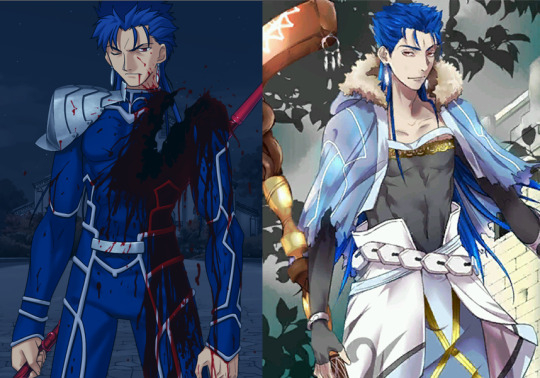
which brings me to something else I believe is very important here: cu chulainn’s heroic fate. because the thing about that is, he may have had that prophecy to ensure the result, but cu chulainn is a hero by choice, not by fate. he’s a demigod and a monster and was prophesied to great glory and untimely death, but his bond ce confirms that long before any of that was relevant he independently decided that he wanted to become a hero, and he continued to make that choice time and time again as he was repeatedly made to prove himself. even cu alter, the most monstrous we’ve seen him so far, insists on maintaining the dignity of a hero. he has aspects of gods and monsters alike but regardless of what his origins are, cu chulainn is the result of choosing the side of humans as a hero. his tragic fate is his own choice, and gae bolg’s ability to always hit the heart that represents this fate is a feature he made himself. as long as cu chulainn has gae bolg he will always be a hero, even if that weapon puts him on the level of a god, even if the bones it was made of make him look the part of monster, because it embodies his choice to be a hero.
the reddit post mentions it’s extremely likely that cascu will appear in lb6 and I agree, so let’s make a short detour to talk about someone else with a god level spear who is related to a camelot chapter. that’s right, I’m talking about lancer arturia alter! she noticed rhongomyniad elevating her to godhood and forcibly turned herself alter in order to remain human, even if it leaves her clinging to existeence with bleeding fingertips. notably, she appeared in the kara no kyoukai event where she is assumed to be an empty suit of armor, the same event where caster cu insists there’s no cu chulainn here. cu alter is a monster king but chooses the pride of a hero even so, a chapter later lancer artoria is a divine king who didn’t make the choice her alter did, saber alter is the person guarding the grail back in singularity F where we first meet caster cu, various forms of saber and cu keep circling each other in this “once is a fluke, twice is coincidence, thrice is a pattern” kind of way. lartoria alter is also one of the leaders of the wild hunt, same as odin, so there’s dots to connect there as well.
what am I getting at, you ask? I’ll tell you what I’m getting at. cu chulainn inherently has the capacity to be(come) the god odin, but chooses to be the hero cu chulainn instead.
here’s where the proof gets tricky and I have to veer off a little further into speculation rather than simply listing what’s right there in the text, because the missing puzzle piece is the reason why scathach is skadi. it seems the game is purposely vague about that in how it handwaves it as “they share a similar origin” without any further specifics or bringing it up in story, even though there’s plenty other heroic spirits with similar origins who don’t take each other’s names, like siegfried and his scandinavian counterpart sigurd (who are arguably much closer connected than scathach and skadi). even if the truth is indeed that their origin is simply similar and they blended together, it’s strange that scathach-skadi’s profile so strongly insists that she’s predominantly skadi when her noble phantasm is scathach’s gate of skye. a similar case is actually clytie van gogh, who is said to be predominantly clytie but even so her two noble phantasms are both van gogh’s, and curiously enough scathach-skadi featured in van gogh’s event as well.
what is the reason for skadi being skadi and scathach being scathach even though skadi uses scathach’s gate and scathach uses skadi’s runes? if their origin is similar enough that their true names are getting combined, why are they still different? this is where it becomes theory instead of simply fact: the key lies in their decision to be either scathach or skadi. this mysterious shared origin of theirs at some point made a choice between siding with humans, gods or monsters, and the difference in that choice is the difference in their person.
scathach is an immortal witch from the land of shadows but before that she was, as far as we know, simply a human who worked her ass off until the world itself was like “wow hold up, one human can’t do that much in their lifetime, you have to be immortal for this to make sense.” scathach HATES being immortal. as far as she’s concerned she’d much rather have died as a human, because all her human achievements became void now that she has infinite time to achieve them. her disposition as a teacher is a natural extension of this mindset: what scathach values the most of all is humanity’s potential to achieve impossible things in their limited lifespans. she is no longer human herself but she can still choose humanity’s side, and therefore she is scathach the godslayer.
skadi on the other hand is a goddess inherently superior to humans, who cares for them from a place of taking responsibility for them rather than guiding them to achieve their potential. she lacks scathach’s skill or drive to improve as a warrior, and it seems that as “shining bride of the gods” she was more preoccupied with the happenings of other gods than those of humans. the skadi we meet had a lot of her options taken away as only survivor of ragnarok but she decided to live on as scandinavia’s divine guide and insisted on treating all of existence equally. skadi’s material profile notes that if she were to use her full authority as skadi, to choose the side of gods, the part of her that is scathach would shatter. but lostbelt skadi couldn’t pick the side of gods anymore now that she was the only god left. as someone with the aspect of giants she could have chosen the side of monsters as well, but instead she kept a careful balance between humans, monsters, and the one goddess left and therefore she is scathach-skadi, an existence somewhere between the scathach that unequivocally chose humanity and the skadi that unequivocally chose divinity.
the situation is again similar to van gogh, whose existence is suspended between van gogh as human, clytie as monster, and the foreign god as divinity, and each of her ascension stages reflects one of those aspects. this would imply a third scathach(-skadi) who chose monsters, wouldn’t it? conveniently for my theory there does indeed seem to be a third one; skadi’s material profile mentions that summoning a scathach-skadi with a disposition closer to panhuman scathach is possible, and scathach’s material profile mentions that her body has another “stage” to it, which caster cu also mentions in the knk event. clytie van gogh’s noble phantasms are van gogh’s because she chose to side with humans, likewise scathach-skadi’s noble phantasm is scathach’s because, in letting herself be summoned to chaldea, she implicitly chose the side of humanity as well.
now, back to cu chulainn and odin. cu and scathach are deeply tied as “the one who gets to kill you/me”, scathach and skadi share an origin, skadi and odin share a connection as norse gods and possibly lovers, cu chulainn and odin share an unspecified connection, and skadi feels poignant but unspecified emotions when she sees cu. caster cu’s first noble phantasm is a druid technique that never actually existed to match a cu chulainn who isn’t supposed to exist either, and his second noble phantasm is the full power of odin’s runes, unused by him because odin supposedly placed some kind of use restrictions on it. meanwhile cu’s personal modifications of gae bolg make it a spear similar to but more powerful than gungnir and altera reads him as norse rather than celtic, so it’s not only caster who suddenly has ties to odin, this is something inherent to all cu chulainns.
remember what I keep saying about choice? scathach and cu chulainn are both heroes of the human order because that is the choice they made, regardless of their origins. extrapolating from the relationship between scathach, skadi, and cu to fill the gap odin leaves, what we can conclude is this:
cu chulainn and odin share an origin similar to the way scathach and skadi do, cu is simply the one that chose humanity while odin chose divinity
what this means for their exact relationship I can’t say, because it’s super vague what “origin” even means in this context. is it the origin of their literary tradition? is it their character concept? digging through the material books with my limited jp knowledge it seems the kanji used differ from those of the nasuverse magic concept “origin”, but even so it’s interesting that so many of the clues tie into the apartment complex that souren araya used to research origins.
scathach and skadi aren’t directly related nor are they plausibly the same person, although skadi refers to scathach as her “other self” there is no indication that scathach does the same. what is notable is that “scathach” comes first in their combined name, skadi prefers “scathach-skadi” or “scathach-sama” over simply “skadi”, and skadi respects and fears scathach for her outrageous competence, confidence, and dependability. likewise, even if cu chulainn indeed shares an origin with odin, it’s explicitly stated that his gae bolg is more powerful than odin’s gungnir. cu could beat odin in a fight, scathach can snap skadi over her knee like a twig. those that chose the side of humanity are the more powerful and respectable ones, because this is fate and we will always choose humanity above anything else. that is why I say it is cu chulainn who takes odin’s place rather than the other way around.
right now the biggest mystery with no way to solve it yet is actually lugh’s identity, and by extension the identities of the whole celtic pantheon. as much as we’ve gone into various pantheons, the norse and celt gods are still a suspiciously large mystery. it's not unlikely that lugh and odin are the one with the shared origin instead, and it carries over into cu as lugh’s son. it could be that nasu read the same bit of old academia I remember reading and plays it as cu being an incarnation of lugh as well as his son. with the new valentines event a fha collab that brings up bazett’s ties to lugh is more likely every day. whether I’m right, and what the specifics of the situation are in case I’m indeed right, are something only time can tell.
honestly though, if it turns out all of this is wrong and caster cu WAS in fact odin all along I’ll still feel vindicated for how my first reaction upon seeing him back in 2015 was “hold on, this doesn’t seem very cu-like of him.”
that’s all I got for theory directly extrapolated from fact, to wrap it up it’s time for some speculation and wishful thinking based on vibes alone.
lb6 as a whole seems to strongly be about “who you are meant to be”, about your destined potential. miss castoria is so different from OG saber that she lacks the name pendragon and it’s even possible to argue that she’s outright an artificial construct made by miss merlin, but even so she is “the once and future king that will come to britain’s aid”. its assigned crypter beryl is a beast in human clothing, and he is openly disdainful of the idea of living up to his potential. “becoming my best self is something I’d never want.” he says as he kills kirschtaria for trying to elevate humanity to godhood. beryl delights in failing to live up to his potential, in not being what he could or was meant to be.
caster arturia’s bond ce says “not a single thing is different. not a single thing is the same. for you have already met your other self.” which will no doubt smack me in the face with what it actually means hard enough to crack skulls once lb6 actually comes around. lb6 no longer has a fantasy tree and is maintained with rhongomyniad, the divine lance that forced arturia to choose between humans and gods. the lostbelt itself is a world of fairies rather than humans.
nothing is different. nothing is the same. you have already met your other self. your origin, your potential, is realized through a choice. you can be a god. you can be a monster or fairy. you can be human. all of those are the same, all of those are completely different. the only difference is the choice, and that choice makes all the difference.
gae bolg is the symbol of cu’s heroic ideal. it’s his choice to side with humans. and while caster cu’s materials state that getting his spear back isn’t his primary goal and he’s assigned himself the role of guide for now, he still misses it a lot. he doesn’t feel right not being a hero, he’s just acting the way he thinks a caster should, and possibly the only reason he even manifested like this is because this part of him was forcibly split off.
the god level lance that maintains lb6. the god level spear made through his own choices. the fairies that he as druid has a stronger connection with than usual. his existence on the interstice between human god and monster, different in every form yet always exactly the same person. and, the use restrictions on ochd deug odin.
sooner or later caster cu is going to get his hands on a spear. it is going to be gungnir. the restrictions on ochd deug odin will be lifted and he is going to unleash the full force of odin’s magic. and he will still be cu chulainn.
646 notes
·
View notes
Text
I just realized how similar Enya looks to Kris Jenner


#doppelganger#conspiracy theory#conspiracies#meme#funny#kris jenner#enya#the celts#kim kardashian#kardashian family
0 notes
Text
Rangers Apprentice: Burning Bridge but Will Names The Chapter Titles
ask, and you shall receive!
Prologue: Not For The First Time, I Lose My Nerve.
Chapter One: The Book Just Started, And Im Already Confused.
Chapter Two: One Man May Be Deceit. Two Can Be Conspiracy. Three Is The Number I Don’t Trust Because Gilan Is In Charge Of This Quest.
Chapter Three: Gilan And Horace Teach Me Manners.
Chapter Four: Horace Enjoys Testing My Patience.
Chapter Five: Gilan Teaches Us How To Stab Eachother.
Chaprer Six: In The Famous Words Of Lady Pauline: Brouhaha
Chapter Seven: We Visit The Most Boring Town Ever.
Chapter Eight: Alyss Replaces Me.
Chapter Nine: We Use Sticks To Defend Ourselves From Old Men.
Chapter Ten: Alyss Teaches Halt Some Diplomatic Skills.
Chapter Eleven: Gilan Spies On Horace And I, And Doesn’t Even Bother To Let Us Know.
Chapter Twelve: Alyss Is Disrespected, So Halt Turns To His True Skill: Moat-Throwing
Chapter Thirteen: As If Things Couldn’t Get Any Weirder, We Meet A Girl.
Chapter Fourteen: We Get Ditched By Gilan.
Chapter Fifteen: Pickles And Wargals.
Chapter Sixteen: I Get My First Look At A Wargal, And Boy Are They Ugly.
Chapter Seventeen: We Follow Our Potential Murderers.
Chapter Eighteen: The Celts Build The Bane Of My Existence
Chapter Nineteen: A Celt Miner Drops Morgaraths Plans
Chapter Twenty: I Should Have Done My Geography.
Chapter Twenty-One: Simple Problems Require Simple Solutions: Fire.
Chapter Twenty-Two: Gilan Makes It To Araluen In One Piece.
Chapter Twenty-Three: I Burn A Bridge (And Fail Miserably)
Chapter Twenty-Four: Oh Look, Its Skandians Trying To Kill Us. Yay.
Chapter Twenty-Five: I Succeed With Said Bridge-Burning, And Get Rewarded With A Rock To My Head.
Chapter Twenty-Six: Horace Arrives At Araluen With Three Horses, and Bad News.
Chapter Twenty-Seven: I Wake Up To A Skandian In My Face.
Chapter Twenty-Eight: The Lord Of Rain And Night Puts On A Show For Us.
Chapter Twenty-Nine: My Beautiful Oakleaf Necklace Catches Morgarath’s Attention.
Chapter Thirty: Halt Becomes A Skandian For A Day.
Chapter Thirty-One: The Wargal Army Gets Stampeded.
Chapter Thirty-Two: Horace Throws A Glove At Morgarath.
Chapter Thirty-Three: Horace Decides That One Year Of Training Is Enough To Defeat The Most Feared Knight In The Kingdom. Logic.
Chapter Thirty-Four: Horace’s Sense Of Overconfidence And Logic Seems To Win In His Favor.
Chapter Thirty-Five: Halt Makes A Promise. One I Will Never Forget.
#oh bOy this took way longer than expected#i didn't know burning bridge had this many chapters dshuaoda#i swear i think i listened to about 50 different music albums whilst listening to this#im going to sleep now because im behind like 5 hours dhsadsasdsa#rangers apprentice#ranger's apprentice
109 notes
·
View notes
Text
Historical July IV: Pompeii (2014) - Part I
...Really? This guy made a historical epic?

The Mortal Kombat director? The Monster Hunter director? The director of the first six Resident Evil films? Yeah, THOSE. The director of Death Race 2000? He made a history movie? And it was about one of the greatest natural disasters ever recorded? Oh boy, I cannot WAIT to see how this goes. OK, so what exactly is the big deal about Pompeii. To understand that...take a jump to the left.

There’s a reason that so many of these films are centered around the Roman Empire; it was kind of a big fuckin’ deal. And by the time we get to 79 AD...a lot of shit had happened. Jesus Christ was executed around 30 or 33 AD, and his new followers, called Christians, were not exactly permitted in Rome. A dude named Paul the Apostle goes on missionary journeys to spread Christianity. Even writes a few chapters in a book about the guy, which he adds onto the Jewish scripture as a sort of New Testament. Not that any of that’s gonna go anywhere, but good on him for the initiative.
On the throne, Tiberius has died, only to be replaced by his nephew, Caligula. And Caligula...was kind of a lot.

It’s not entirely known how many of the stories about him are true, but some of them are...controversially sexual. Dude was said to be a sexual sadist who through lavish expositions of debauchery, and some sources list him as being insane. But again, some of that is hearsay. We do know that he improved Roman infrastructure, and that he increased the power of the emperor for succeeding generations. And possibly quite harshly. In any case, in 41 AD, a few senators got pissed off enough by him, and pulled a Cassius/Brutus/Gretchen Weiner and assassinated the SHIT out of him.
Meanwhile, surprise! Things aren’t going great for the Jews. Yeah, history has NOT been kind to them, and around 41 AD, the new emperor of Rome, Claudius, decides to give them the boot and expels them from Rome...for the third time. Yeah, like I said, not a good history for them. To be fair, some of this is hearsay, but there’s no real reason to doubt its veracity. As they were forced out, Claudius focused his interests on Britain, and began to conquer the territories of the Celts. He dies in 54 BC, and is succeeded by...
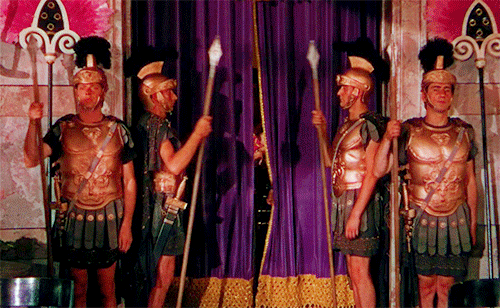
Oh, shit. This is Nero, the last of the first line of Roman emperors, and one of the worst that they’d ever seen. On the bright side, dude was huge into the cultural life of the Empire, as well as diplomacy and trade. He was an actor, a poet, and a charioteer. On the downside...dude was an absolute asshole. Allegedly. Yeah, it’s hearsay time again. He was insanely popular with Rome’s public, but so many historians list him as an awful tyrant. The most well-known of these tyrannical acts involved the Christians, who were building in size as a group in Rome. Which was, unsurprisingly, not liked by the Senate.
In Brittania, Nero’s armies led a successful conquest of the territory, resulting in the death of the Celt Queen Boudicca in 61. And that is...another story for another day. A good one, though. But all of that took a side to one of the biggest tragedies Rome had ever seen: the Great Fire of 64 AD. It raged for nine days, and destroyed 2/3 of Rome. Which is...a lot. Nero allegedly blamed the Christians, but conspiracies mounted that he had ordered the fire to make room for construction of a palatial complex. But that is, well...hearsay. That hearsay began persecutions of the Christians in Rome, leading to that whole “feed them to the lions” thing, eventually. Meanwhile, in a small colony in Campania, near to the city of Naples..

A massive earthquake hits in 62 AD, destroying much of a tourist town called Pompeii. Nothing else bad will happen to them. They’re rebuilding while Rome is doing the same, and Nero even visits the city in 64 AD, as well as performs in their famous theatre. See, Pompeii was basically a cultural town, and their theater and amphitheater were famous. They would rebuild pretty steadily over the next decade or so, with what funding they could get from Rome or the private sector.
In 68, Nero commits suicide (sort of) after being condemned by the Senate (who hated him, of course) as a public enemy. So ends the first Dynasty. So, uh...who’s the new emperor? Since there’s no declared heir, it’s time to figure out who’s gonna rule. And since it’s Rome...WAR TIIIIIIIIIIME!

Yup. The Year of the Four Emperors kicks off in 68 AD. First, Galba takes over, and fucks over EVERYBODY, including the military and the elite unit, the Praetorian Guard. Said guard kills the shit out of him. The same day, Otho is declared emperor, and he’s gonna be...oh, wait, I’ve received word that the legions in Germania support Vitellus as Emperor, and they’re a fucking really good army! Surely word of this will not aaaaaaand Otho has committed suicide, GREAT.
Looks like Vitellus is emperor! Parades! Banquets! Expensive food that immediately creates debt! Looks like we need money, so let’s make people call Vitellus the rightful heir to their goods and fortune, and then KILL THE SHIT OUT OF ‘EM! That’s not gonna bite us squarely in the rotund ass at all! At least we have the entire army on our side, right? What? Fuckin’ Vespasian commands the African and Judean legions, and they’re declaring him emperor? And they’re marching on Vitellus right now, as he’s desperately trying to bribe his way out of this? Well, maybe it’ll aaaaaaand dead. With that, the year is over, and Vespasian is now Emperor of Rome for the next 10 years. God.

So, Vespasian is now the Emperor, and the next few years aren’t abysmal for Rome. They expand in Britain, he reforms the financial system, and he builds the Colosseum. Dude brings Rome back to stability, beginning the Flavian Dynasty, then dies in 79 AD. His son, Titus Vespasianus, ascends in 79 AD. Dude was a legendary general, crushing the first major Jewish rebellion in 69 (geez, guys, sorry history’s been absolute garbage to you), and then taking and destroying Jerusalem. He completed the Colosseum as well, as would be known as a good ruler in the end. But rulers are only judged by their response to adversity. And adversity...thy name is Vesuvius.

August 25, 75 AD. After bubbling and brewing for a long time, the volcano known as Mount Vesuvius blows its top, and molten rock and ash explode from that top violently. We’re talking a force 100,000 times more powerful than fucking Hiroshima and Nagasaki. Yeah. Holy fucking shit. The eruption was large enough to cover miles of land in pyroclastic flows, flash burning and killing every living thing in its path. These flows buried the settlement of Pompeii. And. Herculaneum. And Oplontis. Oh, and Stabiae. YEAH. FOUR FUCKING TOWNS.
Did you know that shit, because I DIDN’T. The reason we know Pompeii so well is because it was actually most fully recovered. So was Herculaneum, but Herculaneum was much smaller, and didn’t have the whole body imprint thing attached to it. But it’s still a worthy site that deserves to be talked about more. Will this movie do so?
Of course it won’t. Come on.

I want to talk about Pompeii and Vesuvius...but later, LATER! Let’s get into this literal garbage fire of a film, shall we? Can’t wait to see what film mountebank Paul W.S. Anderson has done with this epic historical event. Whoof. If you want to learn more about the day itself, watch @wearewatcher Puppet History’s account of it. More entertaining than I am, I guarantee it.
youtube
SPOILERS AHEAD!!!
Recap

Interestingly, we start with the words of Pliny the Younger, who wrote a famous account of the events of the fateful day. I’ll mention him and his famous uncle more next time, I think. They are, and I quote:
We had scarcely sat down to rest when darkness fell, not the dark of a moonless or cloudy night, but as if the lamp had been put out in a clsoed room. You could hear the shrieks of women, the wailing of infants, and the shouting of men; some were calling their parents, others their children or their wives, trying to recognize them by their voices. People bewailed their own fate or that of their relatives, and there were some who prayed for death in their terror of dying. Many besought the aid of the gods, but still more imagined there were no gods left, and that the universe was plunged into eternal darkness for evermore.
Um...wow. Damn. Holy shit, that’s fucking terrifying. I mean, I already knew this, but retyping it now...FUCK. And also, the movie misquotes this. Technically, it’s a different translation and some paraphrasing, but it’s not the exact quote. But OK, the movie opens with that butchered quote over the famous petrified bodies of Pompeii. And I’ll hand it to them, it’s pretty impressive looking.
youtube
And then, we cut to Brttania in 62 AD. Huh. OK? Far as I know, the battle pictured of the northern Celtic horsemen never actually happened, but it’s not outside the realm of possibility. After all, famous Celt queen Boudicca had just died the year before, attempting to fight against the Roman Empire. So, yeah, this isn’t crazy. The Celts are slain by Romans, led by the general Quintus Attius Corvus (Keifer Sutherland), and their bodies are piled up, while others are...hung from a tree, which doesn’t seem like a Roman thing to do. I guess it’s technically gibbetting, but I thought the Celts did that to the Romans, not the other way around!
But OK, let’s not split hairs. I’ll be here all day if I do. A child escapes from the massacre, and flees into the woods. His mother was killed in front of him by Corvus, and his father was ne of the guys in the tree. Eventually, he’s caught by slave traders, and...Conan the Barbarian, is that you?

Yeah, this is just the story of Conan the Barbarian! What’re you gonna do, strap him to a wheel for seventeen years?
So, 17 years pass...and we cut to Londinium. In a gladiator pit with terrible lighting, we meet a manager of gladiators, Graecus (Joe Pingue), who’s being all Roman and shit. You know, being fat, eating grapes, so on and so forth. He’s all annoyed at being brought out here in the poorly lit rain to watch a gladiator fight, especially because the gladiators kinda suck. And that’s when...the Celt comes in.

Oh my God, I already hate this fucking movie. It’s just so...stereotypically late-2000s. It’s like Paul W.S. Anderson went to Frank Miller, whom I picture as living in that fetish house from 300, and said to him, “Teach me your unsubtly homoerotic ways!” And then Frank Miller talked about women and Muslim people in a misogynistic and racist way for, like, three hours, until eventually just lending Anderson a copy of 300.
Anyway, yeah, this is Milo (Kit Harrington), AKA the Celt. He’s just the best gladiator that ever gladiated, and they decide to take him out of there to see how well he does in more professional circles. He’s put on a procession to Pompeii, and meets a woman in-they’re gonna fuck.

Look...they’re gonna be the main couple of the film. Duh. FUCKING DUH. THIS IS JUST PEARL HARBOR IN ANCIENT ROME. Anyway, this Inevitable Love Interest is Cassia (Emily Browning), attended to by her assistant, Ariadne (Jessica Lucas). Their horse was injured on the way to Pompeii, but Milo offers to help it. And he does so by...breaking the horse’s neck.
And I get it, he’s putting it out of its mercy, that’s entirely fine in this circumstance, but...he breaks it as easily as I blow my fucking nose! Like...like picking up a child’s napkin from a fucking table at a birthday party, IT WOULD NOT BE THAT FUCKING EASY! So...yeah, that’s incredibly stupid, and the tone is set for this movie. And of course, Cassia comes away from it like, “Ooh, that silent horse-killing gladiator slave man is, like SUPER-FUCKING-HOT, amirite?” God, this is gonna piss me off.

Cassia, it turns out, is from Pompeii, and her father Severus (Jared Harris) is the city governor, while her mother, Aurelia (Carrie-Anne Moss)...has the worst British accent I’ve ever heard, holy SHIT, Carrie-Anne. I liked you in The Matrix, and I fucking LOVED you in the first season of Jessica Jones, but GODDAMN are you absolutely terrible in this movie so far. But yeah, Cassia’s the rich girl who’s life is perfect and has horses and yaaaaaaaay
Meanwhile, Milo’s dealing with administrative issues, as his fellow gladiators start a fight in the cafeteria. This catches the interest of fellow gladiator Atticus (Adewale Akinnuoye-Agbaje), the black best friend of the movie, probably. Which is also very Gladiator, now that I think about it. Have I mentioned that I fucking really hate this movie so far?

Anyway, one of Cassia’s servants (who is black, because this movie is very awkward in a lot of ways) takes out her horse for a run that night, only for him to die by upcoming plot device. The next morning, Milo meets Atticus, says that he’ll have to kill him one day, gets saved from death by one of the assholes from the cafeteria, then says that he won’t kill Atticus, and I hate this movie.
Meanwhile, Corvus arrives in town, BECAUSE OF COURSE HE DOES, and I now have to wonder...was Pompeii anywhere near this major of a town to warrant this much fucking attention? Well, after looking into it...I mean, kinda. Naples isn’t too far away, so I feel like that would’ve gotten more attention. But anyway, Corvus is invited into the home of Severus to discuss their grand plans for Pompeii, whatever those’ll be.
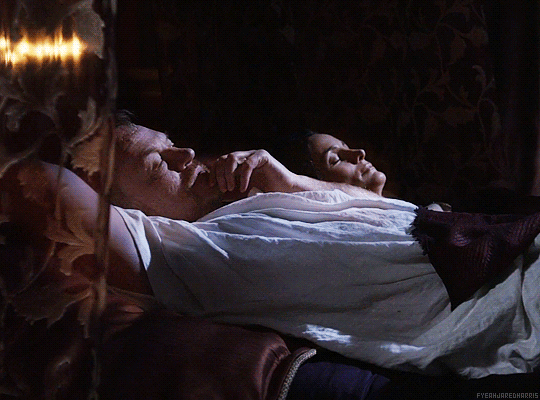
Cassia’s not extraordinarily happy about that, because she dislikes the corrupt new emperor, Titus Vespasian, who...who is one of the most generous and greatest emperors that Rome ever had...period. I...but...we...WHY? WHY ARE WE PAINTING THIS GUY AS AN ASSHOLE, THEN? Just to paint Cassia as a morally-perfect being whom all the edge Celtic gladiators can fall in love with I FUCKING HATETHISSTUPIDSHIT
...OK, maybe I’m overexaggerating here. Fresh eyes, fresh mind, let’s get back into it. After Cassia’s horse returns without his keeper, we switch back to the prison, where said edgy Celt is being all edgy about the whole gladiator thing again. Meanwhile, Atticus is the wide-eyed optimist, believing that he will be freed once he defeats Milo and wins the day. Also, he has a really bad-looking scar. Like, picture a scar with stitches. The most stereotypical scar you’ve ever seen. Yeah. That’s on Atticus’ cheek.

The gladiators are marched into the palace, because this film doesn’t really understand the difference between normal gladiators and normal slaves in terms of treatment. But it’s there that he sees one of the guys present at the destruction of his village, because of course he does. We also learn that the gladiators are treated not only as slaves, but as prostitutes...which DID NOT fucking happen. There is NO PROOF that this happened, and I feel like that would be a risk that managers wouldn’t want to take for various reasons.
Cassia might be wishing that was the case, though, because she catches Milo’s eye at the party. But she’s soon led away to be introduced to Corvus, who she already apparently...oh, goddamnit. It’s also this story? Corvus is gonna wanna fuck her, huh? I just...this movie is a living, breathing stereotype of a film.

But just then, Cassia’s horse starts freaking out SO FUCKING HARD that she excuses herself from Corvus’ advances. And yeah, he does wanna marry her, and has wanted to since she met him in Rome and said no. Anyway, she gets the best horse killer she knows, Milo, and has him tame her horse’s wild nature. And despite having no proof that this’ll work (or that he won’t kill this horse just like the other one, which would be hilarious), it does indeed work.
Cassia goes in, and they share their mutual hatred of Rome together. They also get on the horse together, and burst out of the stable to ride off into the sunset. I...just...this would not only have SO MANY TERRIBLE RAMIFICATIONS, but would also be insanely unlikely due to class structure at the time. This is just...so dumb.

OK, so let’s fast-forward this bullshit, huh? They get caught, Cassia asks Corvus to spare his life, and he agrees to do so if she agrees to fuuuuuuuuck’im, and she does. Corvus makes sure he’s whipped, and then arranges it so that Milo fights first the next day, and ideally dies first. Back in her quarters, Cassia pines for Milo, and back in his quarters, Milo gets wine dumped on his back to heal his terrible looking whip-wounds.
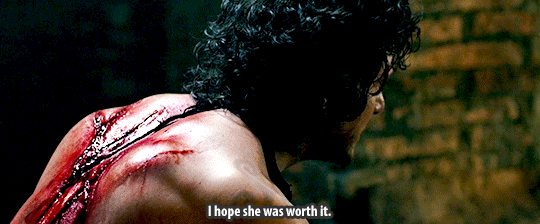
And as Milo and Atticus share their hatred for the Romans, the earth shakes beneath their feet, which Atticus states is a sign from the gods. And given what’s about to happen...yeah, could be. The next day, the quakes continue as the arrangements are make for Milo to die, hopefully.
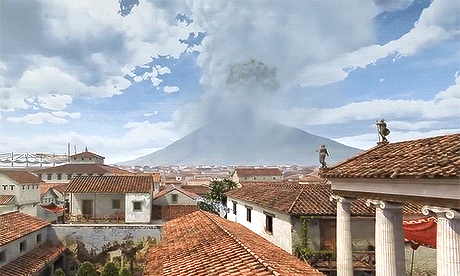
God. I need a break.
Imma rewatch that Puppet History video really quick. See you in Part II, I guess.
#pompeii#pompeii 2014#movie: pompeii#paul w.s. anderson#kit harrington#emily browning#keifer sutherland#adewale#adewale akinnuoye-agbaje#jessica lucas#jared harris#carrie-anne moss#historical july#user365#365 days 365 movies#365 film challenge#wondrous history#wearewatcher#puppet history#mount vesuvius#the eruption of mount vesuvius#vesuvius#but if you close your eyes#does it almost feel like nothing's changed at all#and if you close your eyes#does it almost feel like you've been here before#how am i gonna be an optimist about this
46 notes
·
View notes
Text
The Breton Migration
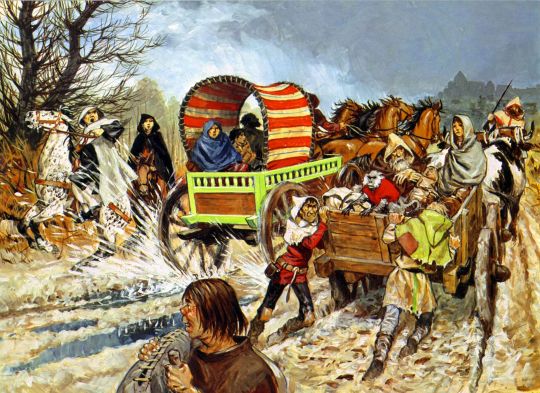
My French Genetics writing got me thinking more about Brittany, and how many academics still believe that the Bretons came from SE Wales fleeing from the Anglo-Saxon invasion. This is due to erroneous medieval assumptions and not historical fact. Our sources on the centuries between the retreat of Rome and the High Middle Ages are very scant, often relying on earlier, possibly faulty accounts instead of direct folk memory, so misconceptions can propagate easily. There is much that we simply can't know. Nonetheless, we have enough to dispel myths and piece together a true story.

The area in question is Armorica, now called Brittany, which is now politically controlled by France. Since the advent of the Celts in Europe, this peninsula has been populated by Armorican Gauls. In the time of Caesar these tribes included the Osimii, the Venetii, and the Curiosolites. We can assume that after the Roman conquest, they lived as typical, if rural, Roman subjects. We can assume they sent their druids to meet in Gaul and Britain with other druids of the area. A Byzantine writer Procopius tells us in the 6th century, that the people of Armorica had the task of ferrying the souls of the dead to Britain. The story goes:
The people of Armorica heard a knock on the door at night, and a low voice calling them. They went to the coast and found boats there weighed down with the souls of the dead, so that the gunwales barely stayed above the water. Leaving from Baie de Depassés at the tip of Armorica, the men would row the boats across the channel to Britain, at which point a voice would call each soul by name, and each soul would disappear when called.
Thus went the druid religion of the Gaulish Armoricans.
But the Empire didn't last forever, and Armorica, being on the far west of the continent, was either thrown around by the political machinations of the Gaulish courts, or so isolated that they weren't even concerned. By 409 the Armoricans, as Zosimus tell us in his "New History",
Encouraged by the example of the insular Britons, had thrown off the Roman yoke. This British-Gallic secession occurred in the time of the Emperor Constantine.
The next year, 410 AD, is when the official retreat of Rome came, and Emperor Honorius told the cities of Britain to "look after themselves." Rome was too weak to hold onto either Britain or, it would seem, Armorica.
We've established the lack of Roman control of Armorica, now we must discover where the new people, the Britons or Bretons, came from.
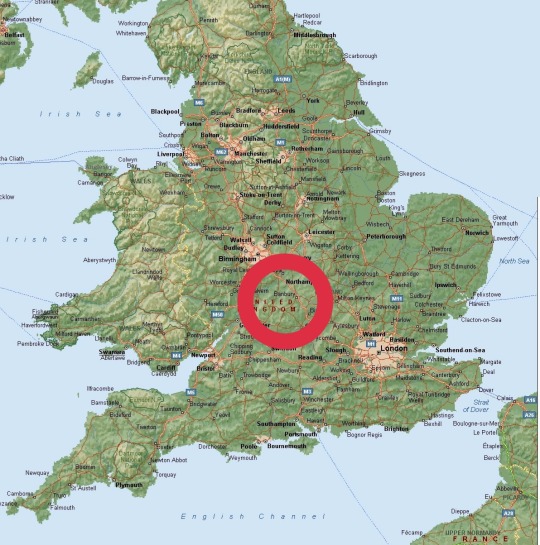

The common narrative is that the Bretons came from central Britain, fleeing from the encroaching Anglo-Saxons; they are essentially Welsh. This idea comes from Gildas (as well as some others, such as Nennius and Eginhard), who said that, 1) the Bretons fled their island from the Anglo-Saxon invaders, and 2) the leaders and generals of the Bretons came from SE Wales. Both of these are misleading. Gildas' account has the Bretons coming from around the above area, and fleeing over the sea through Wales. However, linguists have shown that the Breton language is closest to Cornish, and that many sentence structures common in Breton and Cornish only appear in poetical Welsh. We can see, therefore, that the Bretons could not have come from Central Britain or Southeast Wales, because their language would be closest to Welsh. They instead must have come from Devon starting around 410 AD. What do we make of Gildas' accounts then?
Gildas only states that the aristocrats and military leaders of the Bretons came from Wales, presumably because they had such experience fighting Saxons, that they would be useful against Saxons in Gaul. At the retreat of the Roman Empire from Britain, the island was set upon on all sides by barbarian raids, from the Scots (Irish), Picts, and Saxons. Each was ferocious as the other, enough to be called a "barbarian conspiracy" by Ammianus Marcellinus. I've gone through the extent of the Irish raids before, and how they settled much of West Britain, and especially in the case of the Bretons, the south coast of the Severn Sea. It is impossible for the Anglo-Saxons to force out the Bretons beginning in the early 400s AD, because by 500 AD their expansion was halted at the Seige of Mons Badonius. And in 429, St Germanus wrote that Britain was under the control of Britons. We've already seen Procopius's story of the Bretons sailing to Britain from Armorica, and there is ample evidence of cross-sea interchange of people and ideas between Armorica and the Dumnonian Peninsula.
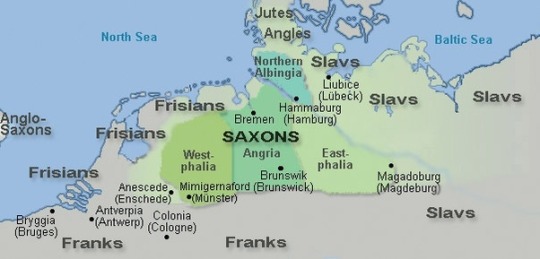
So let's discover the proper story.
In the early 400s, Saxon raiders left their lands in Germania and sailed to the east and south coasts of Britain, as well as to the North of France, as raiders. Because of this new pressure from the east, Roman infrastructure had reorganized itself to accommodate the threat, with all major power centers shifting eastwards. This happened internally in Armorica as well, with all military strongholds now facing the eastern border as well as the coast. A Roman military document, the Notitia Dignitatum, shows that the military command of Northern Gaul was totally removed from the interior and placed around the east and the coast to prevent Saxon landings at all costs. Few measures were taken to protect the west, which allowed the small-scale migration of Celtic Bretons to slip through.

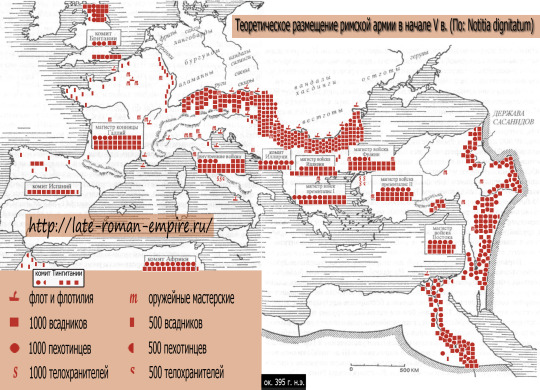
Roman cities such as Nantes, Vannes, and Rennes retained their Gallic language, Roman customs, and Roman affiliation, while the western lands of Armorica slowly filled with this new population which was closely tied to the British Celts. The name Armorica ("by the sea") fades out of use, and the first reference we have to "Brittany" is in a letter written by Sidonius Apollinaris. The people may have called themselves "Lidwiccias", and their land "Lledau" or "Letavia". A Breton tradition tells us that there was, for a time, a double kingdom existing on both sides of the English Channel, ruled by a single King Riwal of Gwent. He came from Eastern Wales and "ruled as 'dux Brittonum' on both sides of the sea until his death."
We have a number of saints' Lives (a biography of the saint) dating from the 9th century, while our earliest Welsh Lives come from the 11th. This, and the constant communication with Britain, indicates a generally high intellectual life in Brittany at the time. So it seems that the Dumnonii people of southwest Britain were not settling Brittany out of flight from invaders, but it was a political expansion encouraged by Irish raids into the Severn Sea. The Bretons expanded willingly into this newly unoccupied stretch of Armorica. As for the formation of a real Breton kingdom, our earliest sources refer to this peninsula called "Prettonaland" as a duchy or a realm, not a kingdom. Frankish sources especially emphasize the dependence of Prettonaland on the Frankish King Childebert.

And while the Franks were expanding their power over post-Roman Gaul under Clovis, the Armorican cities of Nantes, Rennes, etc. recognized the Franks as the rightful rulers of Armorica. The Bretons disagreed. The Franks saw themselves as heirs of Rome, and denied Breton freedom.

The Bretons nominally accepted the title of "Count" in the Frankish court, but this never hindered Breton independence struggles. As the Breton pushed eastward, the city of Vannes was transformed into the city of Bro Waroch ("Territory of Waroch"). Waroch was a lively figure in the accounts of Gregory of Tours, and a major rival of the Franks. In 587 he invaded Nantes, and in 588 he invaded Rennes and Nantes again. In 590 a powerful Frankish army tried to take Vannes, but it was destroyed by Waroch's son Canao. The struggle between Bro Waroch and Frankia lasted for centuries, with the Frankish armies being repeatedly wiped out by the Bretons, but the Bretons unable to hold onto what they had gained. Later, Louis the Pious appointed a native Breton named Nominoë as Count of Brittany, and the same Count then convinced King Charles the Bald to give Brittany independence. The Charles was occupied elsewhere with Viking invasions. With a later successor of Nominoë, named Salomon, Brittany paid tribute and homage to Charles the Bald once again, but within a few years, they had rebelled once more. However, after this failed rebellion, Brittany would enter the feudal world of medieval France. Not peacefully, not willingly, but the destiny of Brittany was forever tied to France. Here is what Arthur III of Brittany said about it in 1458:
I have always served Charles and his kingdom; I am constable, and as such I am bound to comply with the King's orders, but not as Duke of Brittany. I am not a peer of France, since my duchy has never been a part of the kingdom, and it is not a dismemberment of it; and, in order not to compromise the independence of my subjects, I will not appear in Montargis or elsewhere.
Fin

#brittany#celtic#history#france#french history#Britain#british history#bretons#rome#franks#gaul#druid#medieval#dark age#celt#europe#european history#french#emperor#kingdom#duchy#early medieval#Atlantic
20 notes
·
View notes
Note
What other cultures do you think get overlooked? I'm personally fascinated by all of them, but I'd love knowing your opinion!
Well, depends on what you mean by ‘overlooked’. Even if you study archaeology in uni, like I did, most cultures out there aren’t actually accessible to you, because you’re generally offered two options: Classics or Local Stuff. And I mean, in a way it makes sense because Local Stuff is important and Classics is 50% of what shaped Europe so yay, but it’s also not normal that you decide to go to university and pursue your lifelong dream only to find out you got the wrong uni and you’d actually need to move 3000 miles from home and learn an entire-ass language to even start.
(A girl in my course actually did that - trudged through her Bachelor pretending to study Classical Archaeology, and all the while she was secretly cajoling this decrepit and quirky Old English professor into giving her private lessons in Old Norse, and after three years she fucked off to Scandinavia to study Vikings and apparently she spoke like King Baldur the Blacktoothed but it was enough to enrol and understand what she needed?)
So if we’re talking European perspective, generally speaking we should offer more foreign languages to kids starting in primary school and readjust history lessons so that you do learn something about China even if you don’t go and study History in uni.
As for truly forgotten cultures, I’m not sure there are any, because academia is full or nerds studying anything, but it’s true Western Europeans are obsessed with Egypt because Napoleon and mummies and ignore a lot of cool stuff. Like, even Greece - Cycladic culture isn’t a thing normal people talk about, and look at this shit:

Crete is something else that’s not mentioned a lot (other than the ‘Guys we found ATLANTIS’ bs you sometimes find on conspiracy websites). The Near East is mostly neglected because 90% of their texts are either people’s signatures or boring stuff about how many barrels of barley Yukhanna had. Everything and anything taking place in the former USSR is basically off-limits because very little of it has been translated, but you’ve got some fascinating cultures there, like these guys:

I won’t mention stuff outside Europe because I don’t know enough about it (see above for reasons), but another big thing that’s barely started to enter people’s consciousness is prehistory. Like, obviously here another problem was that until recently we didn’t have the science to know much about it (some sites were literally sealed with ‘Do not open until 2030′ tapes, because excavating them without the sophisticated technology that’s needed would destroy them), but now we do have more tools, a lot of new and stunning stuff is starting to emerge. The general public tends to think of prehistory as cavemen dragging women by their hair and possibly hunting dinosaurs, but what we’re seeing are extremely complex societies capable of a high degree of organization. A few years ago we found a sanctuary on a Scottish island that could welcome thousands of people. How so many different tribes managed to reach that remote place at the same time and why they did it remains a mystery. Not to mention the Hallstatt Celts - again, we do know a fair bit about them, but nobody’s making movies called ‘The Revenge of the Salzkammergut Prince’, are they?

So, well, I get it. Ancient Egyptians are suitably weird, there’s lot of macabre material, they left monumental stuff and mummies made good train fuel. Amazing, and nothing wrong with a bit of stanning. But most of our current fiction is made by people who learned about the world through the lens of a Victorian education, and it shows.
#ask#archaeology#students problems#ancient history#ancient greece#scythian#celts#minoan culture#pet peeve#old woman yells at cloud
158 notes
·
View notes
Text
History of Trick-or-Treating

smitsonian
Trick-or-treating—setting off on Halloween night in costume and ringing doorbells to demand treats—has been a tradition in the United States and other countries for more than a century. Its origins remain murky but traces can be identified in ancient Celtic festivals, early Roman Catholic holidays, medieval practices—and even British politics.
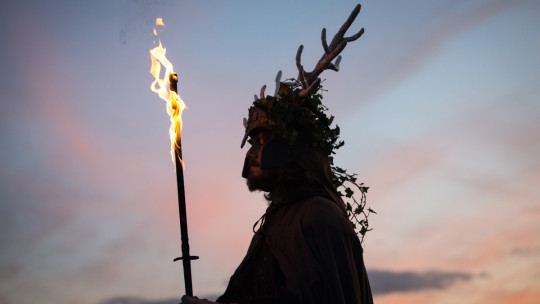
A man representing the Winter King holds a flaming sword as he takes part in a ceremony celebrating Samhain in Somerset, England, 2017. Matt Cardy/Getty Images
Halloween has its roots in the ancient, pre-Christian Celtic festival of Samhain, which was celebrated on the night of October 31. The Celts, who lived 2,000 years ago in the area that is now Ireland, the United Kingdom and northern France, believed that the dead returned to earth on Samhain. On the sacred night, people gathered to light bonfires, offer sacrifices and pay homage to the dead.
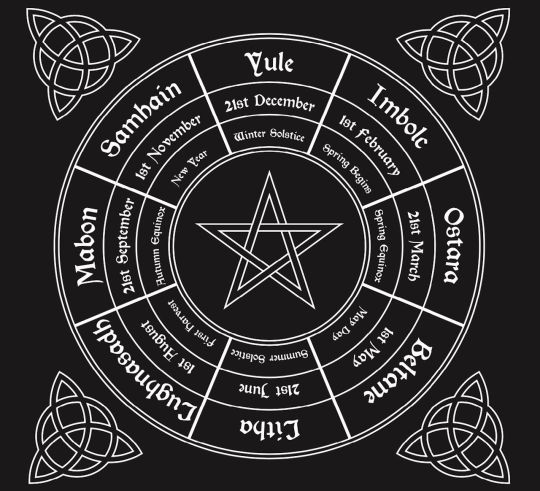
matadornetwork
During some Celtic celebrations of Samhain, villagers disguised themselves in costumes made of animal skins to drive away phantom visitors; banquet tables were prepared and food was left out to placate unwelcome spirits. In later centuries, people began dressing as ghosts, demons and other malevolent creatures, performing antics in exchange for food and drink.
This custom, known as mumming, dates back to the Middle Ages and is thought to be an antecedent of trick-or-treating.
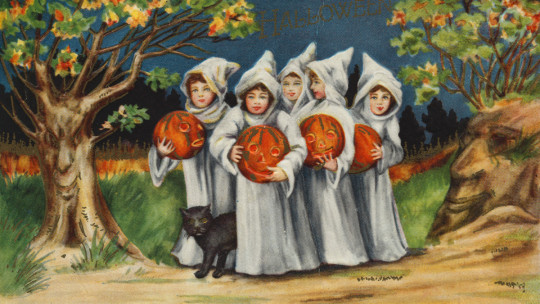
An early 20th-century postcard of children on Halloween. Rykoff Collection/Corbis/Getty Images
By the ninth century, Christianity had spread into Celtic lands, where it gradually blended with and supplanted older pagan rites. In 1000 A.D. the church designated November 2 as All Souls’ Day, a time for honouring the dead. Celebrations in England resembled Celtic commemorations of Samhain, complete with bonfires and masquerades.

Irishimbasbooks
Poor people would visit the houses of wealthier families and receive pastries called soul cakes in exchange for a promise to pray for the souls of the homeowners’ dead relatives. Known as “souling,” the practice was later taken up by children, who would go from door to door asking for gifts such as food, money and ale.
In Scotland and Ireland, young people took part in a tradition called guising, dressing up in costume and accepting offerings from various households. Rather than pledging to pray for the dead, they would sing a song, recite a poem, tell a joke or perform another sort of “trick” before collecting their treat, which typically consisted of fruit, nuts or coins.
Guy Fawkes night celebrations

An effigy of Guy Fawkes is burnt on Bonfire Night, 1952. Bert Hardy/Picture Post/Hulton Archive/Getty Images

Modern-day trick-or-treating also has elements akin to annual celebrations of Guy Fawkes Night (also known as Bonfire Night). On this night, which commemorates the foiling of the Gunpowder Plot in 1605, British children wore masks and carry effigies while begging for pennies. On November 5, 1606, Fawkes was executed for his role in the Catholic-led conspiracy to blow up England’s parliament building and remove King James I, a Protestant, from power.
On the original Guy Fawkes Day, celebrated immediately after the famous plotter’s execution, communal bonfires, or “bone fires,” were lit to burn effigies and the symbolic “bones” of the Catholic pope. By the early 19th century, children bearing effigies of Fawkes were roaming the streets on the evening of November 5, asking for “a penny for the Guy.”
Trick-or-Treating in the United States
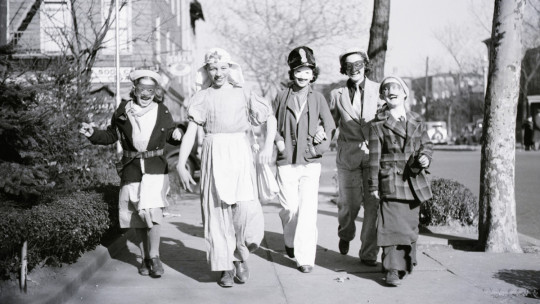
Children dressed up for Halloween in Jersey City, NJ. Bettmann Archive/Getty Images
Some American colonists celebrated Guy Fawkes Day, and in the mid-19th century, large numbers of new immigrants, especially those fleeing the Irish Potato Famine in the 1840s, helped popularize Halloween. In the early 20th century, Irish and Scottish communities revived the Old World traditions of souling and guising in the United States. By the 1920s, however, pranks had become the Halloween activity of choice for rowdy young people.
The Great Depression exacerbated the problem, with Halloween mischief often devolving into vandalism, physical assaults and sporadic acts of violence. One theory suggests that excessive pranks on Halloween led to the widespread adoption of an organised, community-based trick-or-treating tradition in the 1930s. This trend was abruptly curtailed, however, with the outbreak of World War II, when sugar rationing meant there were few treats to hand out. At the height of the postwar baby boom, trick-or-treating reclaimed its place among other Halloween customs. It quickly became standard practice for millions of children in America’s cities and newly built suburbs. No longer constrained by sugar rationing, candy companies capitalised on the lucrative ritual, launching national advertising campaigns specifically aimed at Halloween.
Today, Americans spend an estimated $2.6 billion on candy on Halloween, according to the National Retail Federation, and the day, itself, has become the nation’s second-largest commercial holiday.
https://www.history.com/news/halloween-trick-or-treating
Love it....thank you😊❤️❤️❤️❤️
12 notes
·
View notes
Text
cascu odin configuration speculations rough bullet points bc itll be only a month until we get answers edition
its extremely unlikely that he was just odin all along bc the way cu talks to archer in first order just makes no goddamn sense if he’s not cu, their connection isn’t something you could extrapolate from cu’s myths to impersonate him. like i literally don’t consider this an option if only because i simply do not think type moon disrespects its fans enough to pull a six year long bait and switch with one of their most popular characters. also itd be boring when we can make this identity theft so much more complicated and thematically appropriate
odin just outright trying to possess cu would be the most straightforward option. i don’t know what odin would need to be cu for and this post isnt about that but in this case i would assume cu is without spear because the spear is what ties together his identity as the hero cu chulainn so odin would have to somehow fabricate a cu who is not quite cu in order to slip in between those gaps and actually possess him.
odin needing to make a spearless cu in order to get in there also checks out with archer saying cu’s gae bolg is stronger than odin’s gungnir. gotta get that hurdle out of the way
we can assume cascu’s saint graph from the start was “meant” to be (used by) odin because of ochd deug odin. noble phantasms are representations of heroes and cascu is the one who taught mashu how to use her noble phantasm when she wasn’t yet sure of what hero she was supposed to be/it was restricted by the one it ‘really’ belongs to similar to odin supposedly putting use restrictions on ochd deug odin
i still stick with my age old theory that cascu is a cu without his spear/the symbol of his fate even though that should be impossible because he got cleaved in half by fragarach, the sword that severs fate, leaving cascu without that fate/spear (and also miserable because that fate sits at the core of his identity) and cu alter then picked up that fate and became the spear
mayhaps odin snatched up this incomplete cu that got left over after he was split and filled out the gaps himself to make it into cascu & get him a foot in the door. somewhere. for some reason. some clytie van gogh shit even where they shove the mind of the one in with the body & soul of the other bc skadi Did have that line in imaginary scramble about how she can sorta get how the outer gods think
in this case its also inch resting that the other half was snatched up by medb to turn into cu alter since medb is also tits deep in fairy stuff and the current scraps of fairy lostbelt history we have apparently imply that not-medb and not-cascu have faced off before
mayhaps it’s the other way around and it’s closer to what i said before those new lines came out which is that [the existence we the audience generally know as cu chulainn] has the capacity to be both cu chulainn and odin with the only real difference being whether he sides with humans or gods so when something core to the identity of “cu chulainn” was removed he inevitably and perhaps inadvertently ended up drifting closer to being odin.
would also vibe nicely with the wicker man being an empty cage searching for an offering to the gods. the face and name are cu chulainn but the “core” as hero is missing so something needs to fill that hole
would furthermore have it make sense that in the fairy lostbelt he would have to be odin because cu chulainn could not possibly choose to side with humans in this world where no human heroes exist
some of his new lines are basically the same as his old lines but slightly different so the extent to which he is in fact odin at any given point seems to vary a little
its also possible that odin tried to show up as just himself but because there was this half a cu still conceptually lying around the world like made odin trip and fall into cascus cleavage in the name of recycling and now he’s kinda floating in between being cu chulainn and being odin which is why he bitches about not having his spear so much because having either gae bolg or gungnir would actually pin down his identity as one or the other (yknow like rhongo pinning down the world or whatever because everything is the same)
obviously his name is given as cu chulainn because odin has a history of disguising himself but cu doesn’t so the ‘inconsistency’ in his identity that gets hidden is the one that has a penchant for hiding itself anyway
of course there’s a lot of precedent for (divine) spirits latching onto others in fgo or ppl being granted divine authorities (na should be having a time with that over in lb4 right now) but spas cifically i feel the need to point out the alter ego class who are by and large composed of servants who got mashed together from a bunch of divinities and i also want to remind you my dear readers of the part in the ccc event where tamamo cat explains that you don’t need the alter ego class to be an alter ego
i have a vague suspicion that he’s only “odin” when the hood is up. in his valentines scene he’s mumbling some vaguely out of character stuff with his hood on but goes back to normal once he takes it off and in the knk event he puts the hood on when pretending he’s not cu
again i really want to stress that the base personality we’re seeing has to be cu chulainn and he has to have cu chulainn’s memories not only from life but also as a servant, otherwise he would not be able to reference experiences he had as lancer servant in the fuyuki holy grail war to shadow archer. he is without a doubt cu chulainn, it’s just a matter of how much odin was added.
97 notes
·
View notes
Text
TIL there's a conspiracy theory that the Anglo-Saxon invasion never actually happened. The English made the whole thing up because they didn't want to be descended from those icky Celts.
1 note
·
View note